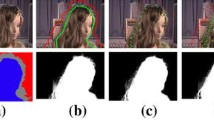Abstract
Alpha matting refers to the problem of softly extracting the foreground from a given image. Previous matting approaches often focused on using naïve color sampling methods to estimate foreground and background colors for unknown pixels. Existing sampling-based matting methods often collect samples only near the unknown pixels, which may yield poor results if the true foreground and background samples are not found. In this paper, we present novel approach to extract foreground elements from an image through color and opacity (i.e., alpha) estimations, which consider available samples in a search window of variable size for each unknown pixel. Our proposed sampling method is robust in that similar sampling results can be generated for input trimaps of different unknown regions. Further, after the initial estimation of the alpha matte, a fully connected conditional random field (CRF) is used to correct the predicted matte at the pixel level. Our experiments show that visually plausible alpha mattes can indeed be produced.











Similar content being viewed by others
Notes
Most existing approaches require additional information via user input, either as trimaps or scribbles. The trimap, as shown in Fig. 1b, identifies known foreground (or background) pixels with opacity value α i = 1 (or α i = 0). The uncertain pixels are marked as unknown.
All numerical values used in this section are determined empirically.
The Chebyshev distance between two points p i and q i is \( \underset{i}{ \max}\left(\left|{p}_i-{q}_i\right|\right) \).
CRFs are used in different computer vision applications, particularly for low-level vision tasks such as image de-noising, optical flow, binocular stereo, and segmentation.
The parameters are specified for different test images used in [10].
References
Berman A, Dadourian A, Vlahos P (2000) Method for removing from an image the background surrounding a selected object. US Patent 6:134,346
Chen Q, Li D, Tang C-K (2013) KNN Matting. IEEE Trans Pattern Anal Mach Intell 35(9):2175–2188
Chen X, Zou D, Zhou S, Zhao Q, Tan P (2013) Image matting with local and nonlocal smooth priors. In Proceedings of 2013 I.E. conference on computer vision and pattern recognition, p 1902–1907
Cho D, Tai Y-W, Kweon IS (2016) Natural image matting using deep convolutional neural networks. In Proc. ECCV
Chuang Y, Curless B, Salesin DH, Szeliski R (2001) A Bayesian approach to digital matting. Proc. IEEE Conf. Computer vision and Pattern Recognition, p 264–271
Gastal ESL, Oliveira MM (2010) Shared sampling for real-time alpha matting. Comput Graphics Forum 29(2):575–584
He K, Rhemann C, Rother C, Tang X, Sun J (2011) A global sampling method for alpha matting. Proc. IEEE Conf. Computer vision and Pattern Recognition, p 2049–2056
Johnson J, Rajan D, Cholakkal H (2014) Sparse codes as alpha matte. In Proceedings of British Machine Vision Conference. BMVA Press
Karacan L, Erdem A, Erdem E (2015) Image matting with KL-divergence based sparse sampling. In IEEE 15th International Conference on Computer Vision, p 424–432
Krähenbühl P, Koltun V (2011) Efficient inference in fully connected CRFs with Gaussian edge potentials. In Adv. Neural Info. Process. Syst. (NIPS), p 109–117
Levin A, Lischinski D, Weiss Y (2006) A closed form solution to natural image matting. Proc. IEEE Int’l Conf. Computer vision and pattern recognition, p 61–68
Levin A, Rav-Acha A, Lischinski D (2008) Spectral matting. IEEE Trans Pattern Anal Mach Intell 30(10):1699–1712
Rhemann C, Rother C, Gelautz M (2009) Improving color modeling for alpha matting. In Proc. British machine vision conference, p 1155–1164
Rhemann C, Rother C, Wang J, Gelautz M, Kohli P, Rott P (2009) A perceptually motivated online benchmark for image matting. Proc IEEE Conf Comput Vis Pattern Recognit:1826–1833
Ruzon MA, Tomasi C (2000) Alpha estimation in natural images. Proc. IEEE Conf. Computer vision and Pattern Recognition, p 18–25, 2000
Shahrian E, Rajan D (2012) Weighted color and texture sample selection for image matting. Proc. IEEE Conf. Computer vision and pattern recognition, p 718–725
Shahrian E, Rajan D, Price B, Cohen S (2013) Improving image matting using comprehensive sampling sets. In Proceedings of 2013 I.E. conference on computer vision and pattern recognition, p 636–643
Sun J, Jia J, Tang C-K, Shum H-Y (2004) Poisson Matting. ACM Trans Graph 23(3):315–321
Tarabalka Y, Fauvel M, Chanussot J, Benediktsson JA (2010) SVM-and MRF-based method for accurate classification of hyperspectral images. IEEE Geosci Remote Sens Lett 7(4):736–740
Wang J, Cohen M (2007) Optimized color sampling for robust matting. In IEEE conference on computer vision and pattern recognition (CVPR), p 1–8
Zheng Y, Kambhamettu C (2009) Learning based digital matting. Proc. IEEE Int’l Conf. Computer vision, p 889–896
Zhu Q-S, Shao L, Li X, Wang L (2015) Targeting accurate object extraction from an image: a comprehensive study of natural image matting. IEEE Trans Neural Netw Learn Syst 26(2):185–207
Author information
Authors and Affiliations
Corresponding author
Rights and permissions
About this article
Cite this article
Lin, FJ., Chuang, JH. Alpha matting using robust color sampling and fully connected conditional random fields. Multimed Tools Appl 77, 14327–14342 (2018). https://doi.org/10.1007/s11042-017-5031-0
Received:
Revised:
Accepted:
Published:
Issue Date:
DOI: https://doi.org/10.1007/s11042-017-5031-0




